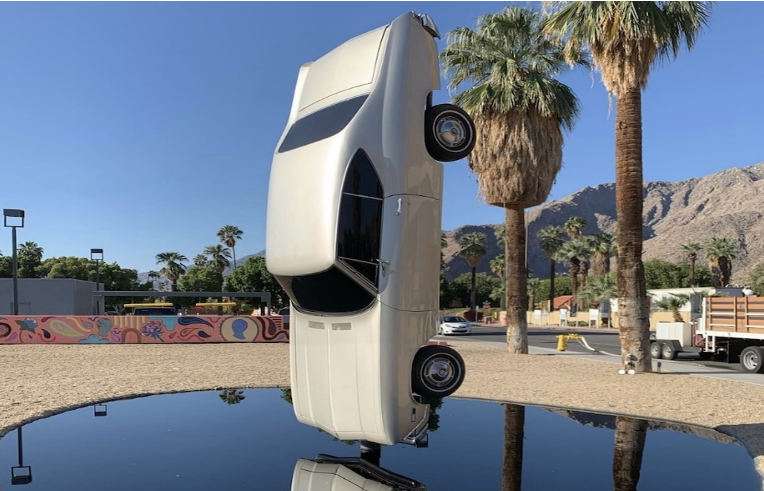CommentsCONNECTING CALIFORNIA--Palm Springs isn’t just a great place to spend a weekend. It’s one of our last and most fervent defenders of what California really is—not what it pretends to be.
That’s because Palm Springs, like the Golden State, is a modernist project, built by people who broke from old tradition and established cultures, and experimented relentlessly to construct new systems that buried the past. Throughout California, modernism has produced freeways that span the state, waterworks through swamps and deserts, culture-dominating industries from Hollywood to Silicon Valley, and brand-new approaches to art, architecture, literature, philosophy, politics, and religion.
But modernism also damaged California communities, structures, and habitats. So, today modernism is in retreat, with post-modernism ascendant. We worship the past, and tell ourselves we want to go backward and restore it. We talk about taking down the dams and interstates, getting back to nature and repairing the environment, staying off our screens and cracking down on the tech companies, and restoring the lands and traditions of our ancestors.
That’s what makes Palm Springs—and its public devotion to modernism—so distinctive. The city is effectively promoting the creation of the new, by looking not forward but backward into its own past.
Palm Springs has long touted its mid-century modern architecture—those 20th century desert homes, with lots of glass and open spaces, that encourage indoor-outdoor living and have become synonymous with California in the American mind.
In 2006, after some years of holding a Modernism Show & Sale and successful symposia on modern design, Palm Springs created a major event—Modernism Week. It’s grown into a colossus of the February calendar, with home tours, bus tours, walking tours, bike tours, garden tours, films, lectures, parties, concerts, fashion shows, and cars shows. There’s now a second, smaller-scale Modernism Week, in the fall. This year, the pandemic expanded the calendar, with Palm Springs hosting an online Modernism Week in February, followed by an in-person week in April.
All celebrate a Palm Springs modernist aesthetic of—as the designer and writer Brad Dunning told Palm Springs Life—“forward-facing the future with open arms and a martini.”
Modernism Week, of course, is about commerce. Palm Springs’s tourist economy needs visitors, local arts-oriented businesses want customers, and real estate interests need to sell local homes. But the event also taps into what might be called a nostalgia for the new.
Palm Springs is keeping alive a time when Californians could violate old strictures and fashion entirely novel things without having to spend years fighting planning commissions or CEQA lawsuits. But Modernism Week also evangelizes for an updating of modernism, to fit the more diverse needs of today.
This year’s Fast Forward/Designing the Future of Palm Springs event showcased a new and decidedly modernist design for affordable housing by local architect Maria Song. Her design for the 60-unit Monarch Apartment Homes on Indian Canyon Way nods to the renowned work of Donald Wexler, the architect of many of the area’s steel-and-glass homes.
Song’s goal is creating affordable housing beautiful and distinguished enough to be embraced by wealthy neighborhoods. “I want people to understand that there is nothing cheap about affordable housing,” Song told me. “Rents are affordable, but not the materials or landscaping or the quality of the building.” The Monarch proposal, being developed by Fairfield-based Community Housing Opportunities Corporation, should produce “a building that opens minds and that any community would be proud to have as part of its fabric,” she added.
That Palm Springs is a citadel of modernism is both appropriate, and rich with contradictions. Is any California community more defiantly modern? This is a lush city in the middle of a desert valley full of golf courses and swimming pools, in a state plagued by drought. The largest landowner in Palm Springs is actually the Agua Caliente Band of Cahuilla Indians, which in recent years has asserted more of its property rights, frustrating the expansive ambitions of some businesses.
Palm Springs is thus, like California itself, caught in a purgatory, between the urge for the new and the demands of the old. In other words, we Californians occupy a no-man’s land, somewhere between modernism and post-modernism. We know we need to create new systems that are sustainable and climate-friendly, inclusive and anti-racist. But we are afraid of displacing stakeholders, or burying the past, or not respecting our ancestors. For these and other reasons, we maintain nearly insurmountable regulations and obstacles to building anything new.
This conundrum can leave us feeling as though we are trapped in time, not sure which way lies the past and which way lies the future. The feeling is expertly captured in a new installation outside the Palm Spring Art Museum by the artist Gonzalo Lebrija. It is a car that is suspended over a pool of liquid—not going in any direction, frozen. The work’s title is “History of Suspended Time (A monument for the impossible).”
If we take inspiration from Palm Springs, we’ll try to go multiple directions at once. We’ll take the risk of creating modern novelties for our post-modern world. And we’ll recognize that the fastest way to restore the past is to go boldly forward into the future.
(Joe Mathews writes California Connection for Zocalo Public Square.) Photo at top: Gonzalo Lebrija, History of Suspended Time (A monument for the impossible) has been lent to Palm Springs Art Museum by Amy Harmon. Photo by Guillaume Goureau
-cw
















